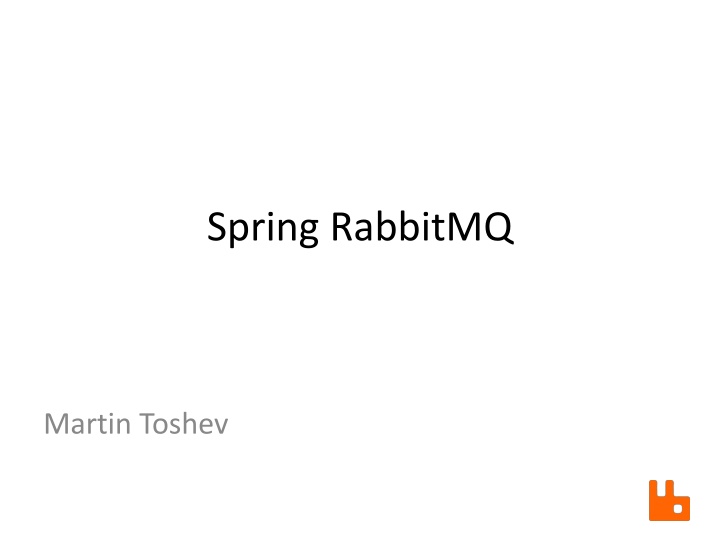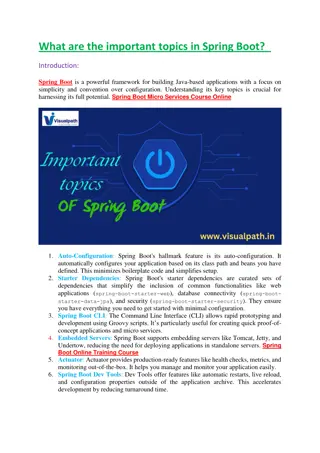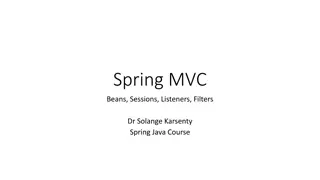Spring RabbitMQ
Software consultant and BG JUG board member Martin Toshev provides an insightful overview of Spring RabbitMQ, discussing its importance in messaging basics. RabbitMQ, an open-source message broker written in Erlang, is explored, highlighting its implementation of the AMQP protocol and pluggable architecture for various protocols like HTTP and MQTT. The content delves into the central role of messaging in loosely-coupled system integration, offering use cases and emphasizing the significance of messaging solutions in securing message transfer and routing. With a focus on RabbitMQ fundamentals and messaging principles, this comprehensive guide is a must-read for those interested in mastering messaging technologies.
Download Presentation

Please find below an Image/Link to download the presentation.
The content on the website is provided AS IS for your information and personal use only. It may not be sold, licensed, or shared on other websites without obtaining consent from the author.If you encounter any issues during the download, it is possible that the publisher has removed the file from their server.
You are allowed to download the files provided on this website for personal or commercial use, subject to the condition that they are used lawfully. All files are the property of their respective owners.
The content on the website is provided AS IS for your information and personal use only. It may not be sold, licensed, or shared on other websites without obtaining consent from the author.
E N D
Presentation Transcript
Spring RabbitMQ Martin Toshev
Who am I Software consultant (self-employed) BG JUG board member (http://jug.bg)
Who am I Just finished a book on RabbitMQ
Agenda Messaging Basics RabbitMQ Overview Spring RabbitMQ
Messaging Basics Messaging provides a mechanism for loosely- coupled integration of systems The central unit of processing in a message is a message which typically contains a body and a header
Messaging Basics Use cases include: Log aggregation between systems Event propagation between systems Offloading long-running tasks to worker nodes
Messaging Basics Messaging solutions implement different protocols for transferring of messages such as AMQP, XMPP, MQTT and many others The variety of protocols implies vendor lock-in when using a particular messaging solution (also called a messaging broker)
Messaging Basics A variety of messaging brokers can be a choice for applications
Messaging Basics Messaging solutions provide means for: securing message transfer, authenticating and authorizing messaging endpoints routing messages between endpoints subscribing to the broker
RabbitMQ Overview An open source message broker written in Erlang Implements the AMQP Protocol (Advanced Message Queueing Protocol) Has a pluggable architecture and provides extensions for other protocols such as HTTP, STOMP and MQTT
RabbitMQ Overview The AMQP protocol defines: exchanges the message broker endpoints that receive messages queues the message broker endpoints that store messages from exchanges and are used by subscribers for retrieval of messages bindings rules that bind exchanges and queues The AMQP protocol is programmable which means that the above entities can be created/modified/deleted by applications
RabbitMQ Overview The AMQP protocol defines multiple connection channels inside a single TCP connection in order to remove the overhead of opening a large number of TCP connections to the message broker
RabbitMQ Overview Subscriber Publisher binding queue exchange queue binding Subscriber exchange queue binding Publisher Subscriber
RabbitMQ Overview Subscriber exchange= xyz routing key= abc payload= bcd Publisher binding queue exchange queue Subscriber binding exchange queue binding Publisher Subscriber
RabbitMQ Overview Each message can be published with a routing key Each binding between an exchange and a queue has a binding key Routing of messages is determined based on matching between the routing and binding keys
RabbitMQ Overview Different types of messaging patterns are implemented by means of different types of exchanges RabbitMQ provides the following types of exchanges: direct/default fanout topic headers
RabbitMQ Overview A default exchange has the empty string as a name and routes messages to a queue if the routing key of the message matches the queue name (no binding needs to be declared between a default exchange and a queue) Default exchanges are suitable for point-to-point communication between endpoints
RabbitMQ Overview Subscriber exchange= key= general payload= XYZ Publisher (AMQP default) general error chat Subscriber warning log binding Publisher Subscriber (AMQP default) is a system exchange
RabbitMQ Overview A direct exchange routes messages to a queue if the routing key of the message matches the binding key between the direct exchange and the queue Direct exchanges are suitable for point-to-point communication between endpoints
RabbitMQ Overview Subscriber exchange= chat key= b_general payload= XYZ b_general Publisher (AMQP default) general error chat Subscriber warning log Publisher Subscriber chat is defined as a direct exchange upon creation
RabbitMQ Overview A fanout exchange routes (broadcasts) messages to all queues that are bound to it (the binding key is not used) Fanout exchanges are suitable for publish- subscribe communication between endpoints
RabbitMQ Overview Subscriber exchange= log key= payload= XYZ Publisher (AMQP default) general error chat Subscriber warning log Publisher Subscriber log is defined as a fanout exchange upon creation
RabbitMQ Overview A topic exchange routes (multicasts) messages to all queues that have a binding key (can be a pattern) that matches the routing key of the message Topic exchanges are suitable for routing messages to different queues based on the type of message
RabbitMQ Overview Subscriber exchange= log key= warning.# payload= XYZ Publisher (AMQP default) general error chat Subscriber warning.server warn.server log warn.client warning.client Publisher Subscriber log is defined as a topic exchange upon creation
RabbitMQ Overview A headers exchange routes messages based on a custom message header Header exchanges are suitable for routing messages to different queues based on more than one attribute
RabbitMQ Overview Apart from queues, exchanges and bindings we can also manage the following types of components: vhosts for logical separation of broker components users parameters (e.g. for defining upstream links to another brokers) policies (e.g. for queue mirroring)
RabbitMQ Overview Administration of single instance or an entire cluster can be performed in several ways: using the management Web interface using the management HTTP API using the rabbitmq-admin.py script using the rabbitmqctl utility
RabbitMQ Overview RabbitMQ provides clustering support that allows new RabbitMQ nodes to be added on the fly Clustering by default does not guarantee that message loss may not occur
RabbitMQ Overview Default clustering mechanism provides scalability in terms of queues rather than high availability Mirrored queues are an extension to the default clustering mechanism that can be used to establish high availability at the broker level
RabbitMQ Overview (demo)
Spring RabbitMQ The Spring Framework provides support for RabbitMQ by means of: The Spring AMQP framework The Spring Integration framework The Spring XD framework
Spring RabbitMQ The Spring AMQP framework provides: RabbitAdmin class for automatically declaring queues, exchanges and bindings Listener container for asynchronous processing of inbound messages RabbitTemplate class for sending and receiving messages
Spring RabbitMQ Utilities of the Spring AMQP framework can be used either directly in Java or preconfigured in the Spring configuration The Spring Integration framework provides adapters for the AMQP protocol
Spring RabbitMQ The following Maven dependency can be used to provide the Spring AMQP framework to the application: <dependencies> <dependency> <groupId>org.springframework.amqp</groupId> <artifactId>spring-rabbit</artifactId> <version>1.4.5.RELEASE</version> </dependency> </dependencies>
Spring RabbitMQ RabbitAdmin (plain Java): CachingConnectionFactory factory = new CachingConnectionFactory("localhost"); RabbitAdmin admin = new RabbitAdmin(factory); Queue queue = new Queue("sample-queue"); admin.declareQueue(queue); TopicExchange exchange = new TopicExchange("sample-topic- exchange"); admin.declareExchange(exchange); admin.declareBinding(BindingBuilder.bind(queue).to(exchange) .with("sample-key")); factory.destroy();
Spring RabbitMQ Container listener (plain Java): CachingConnectionFactory factory = new CachingConnectionFactory( "localhost"); SimpleMessageListenerContainer container = new SimpleMessageListenerContainer( factory); Object listener = new Object() { public void handleMessage(String message) { System.out.println("Message received: " + message); }}; MessageListenerAdapter adapter = new MessageListenerAdapter(listener); container.setMessageListener(adapter); container.setQueueNames("sample-queue"); container.start();
Spring RabbitMQ RabbitTemplate (plain Java): CachingConnectionFactory factory = new CachingConnectionFactory("localhost"); RabbitTemplate template = new RabbitTemplate(factory); template.convertAndSend("", "sample-queue", "sample-queue test message!");
Spring RabbitMQ All of the above examples can be configured using Spring configuration Cleaner and decouples RabbitMQ configuration from the business logic
Spring RabbitMQ The following Maven dependency can be used to provide the Spring Integration AMQP framework to the application: <dependency> <groupId>org.springframework.integration</groupId> <artifactId>spring-integration-amqp</artifactId> <version>4.0.4.RELEASE</version> </dependency>
Spring RabbitMQ The Spring Integration Framework provides: Inbound-channel-adapter for reading messages from a queue outbound-channel-adapter for sending messages to an exchange
Spring RabbitMQ (demo)
Thank you ! Q&A



















